A novel alkali and cosolvent thickening mechanism for latex†
Abstract
The study presented here reports the synthesis of a recently developed rheology-controlled acrylic latex used in waterborne metallic coatings, which was synthesized from methacrylic acid (MAA), methyl methacrylate (MMA), butyl acrylate (BA), hydroxypropyl methacrylate (HPMA) and divinylbenzene (DVB) via core/shell seed emulsion polymerization. Once the latex was neutralized with dimethylethanolamine (DMEA), it could be further thickened with an additional solvent, ethylene glycol butyl ether (EGBE); in this process the dispersion viscosity increased dramatically and the resin exhibited strong thixotropy. To clarify the thickening mechanism, the swelling behaviour and interfacial properties of the latex with DMEA and EGBE were intensively investigated. Dynamic light scattering (DLS) results revealed that DMEA swelled latex particles to some extent, whereas EGBE could not change the diameter of particles but precipitated the particles. Surface tension experiments demonstrated that EGBE decreased the latex surface tension, and we concluded that amphiphilic EGBE causes particles to flocculate in the latex system. Scanning electron microscopy (SEM) results showed that particles in a sample that were thickened with DMEA and EGBE retained their spherical structure and were arranged regularly. The combination of alkali-swellable properties and the flocculating effect of EGBE were the main factors responsible for thickening of the latex.


 Please wait while we load your content...
Please wait while we load your content...